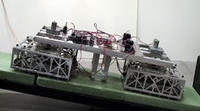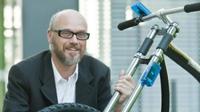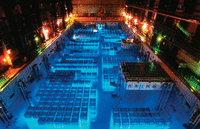-
Solving the major problem of renewable energy: intermittency
Intermittency, sometimes called the Achilles’ heel of renewable energy, has so far limited the penetration of renewable sources in most power grids; engineers imagine an energy future where giant transmission grids are backed up by massive energy storage units
-
-
Company develops telephone line “fingerprint” detector
Researchers at Pindrop, a new security company, have developed technology that can read telephone line “fingerprints” to prevent fraud and identify a caller
-
-
Pasta-shaped radio waves beamed across Venice
One solution to communication congestion during emergencies is to create a public safety-dedicated band of the spectrum, allowing for a unified and uninterrupted communication among first responders; another solution is twisting radio waves into the shape of fusilli pasta, allowing a potentially infinite number of channels to be broadcast and received
-
-
Poultry feathers-based filters remove arsenic from water
Thousands of people die each year in developing countries from drinking arsenic-contaminated water; researchers develop inexpensive filters made from the modified protein (keratin) in poultry feathers to remove arsenic from drinking water
-
-
Energy from differences between salt- and fresh water – produced inland
Production of energy from the difference between salt water and fresh water is most convenient near the oceans, but now, using an ammonium bicarbonate salt solution, researchers can combine bacterial degradation of waste water with energy extracted from the salt-water fresh-water gradient to produce power anywhere
-
-
Snake-emulating search-and-rescue robot

An all-terrain robot for search-and-rescue missions must be flexible enough to move over uneven surfaces, yet not so big that it is restricted from tight spaces; it might also be required to climb slopes of varying inclines; researchers say the solution would be a search-and-rescue robot which emulates the locomotion of a certain type of flexible, efficient animals: snakes
-
-
Researchers develop record-breaking plastic solar cell
Researchers at the University of California, Los Angeles (UCLA) have made a breakthrough with plastic solar cells, creating a record-breaking polymer cell that converts 10.6 percent of the sun’s energy into electricity
-
-
Physicists predict when brittle materials fail
It does not happen often, but structures like bridges, airplanes, and buildings do fail, sometimes catastrophically; what are the odds, and how can it be prevented? Researchers just published new theoretical insights into the probability of structural failures, based on hundreds of thousands of computer simulations
-
-
Detecting explosives from a distance with laser beams
Scientists have found a way to detect chemicals over long distances, even if they are enclosed in containers; the scientists tested the system by trying to detect frequently used explosives, such as TNT, ANFO, or RDX from a distance – and the tests were successful
-
-
Anthrax-decontamination foam used in meth lab cleanup
The meth cleanup problem in the United States is a big one; the U.S. Drug Enforcement Administration lists thousands of locations where law enforcement agencies have found chemicals or paraphernalia indicating the presence of either clandestine drug laboratories or dumpsites; Sandia’s decontamination foam, originally developed to deal with anthrax, is now also a meth eraser
-
-
Future aircraft could capture, re-use some of their own power
When an Airbus 320 lands, a combination of its weight and speed gives it around three megawatts peak available power; researchers work on making the aircraft of tomorrow contribute to their power needs by harnessing energy from the wheel rotation of their landing gear to generate electricity
-
-
Wireless bicycle brake to be shown in Cebit 2012

Scientists have developed a wireless bicycle brake; to brake with the wireless brake, a cyclist needs only clench the rubber grip on the right handle; the scientists say the brake has such a high reliability, only three out of one billion braking attempts will fail; “That is not perfect, but acceptable,” says one of the researchers
-
-
Cell phone-based sensor detects E. coli
Researchers have developed a new cell phone-based fluorescent imaging and sensing platform that can detect the presence of the bacterium Escherichia coli in food and water
-
-
Nuclear waste recycling for better nuclear power generation

Researchers aim to produce safe nuclear fuel that can be 80 percent recycled, compared to the current 1 percent; these fourth generation nuclear power systems can lead to a reduction of the amount of high-level, long-lived nuclear waste to a tenth of what it is today, while energy output can increase hundredfold
-
-
Invisibility cloak to protect buildings from earthquakes
Scientists show that by cloaking components of structures with pressurized rubber, powerful waves such as those produced by an earthquake would not “see” the building — they would simply pass around the structure and thus prevent serious damage or destruction
-
More headlines
The long view
Are We Ready for a ‘DeepSeek for Bioweapons’?
Anthropic’s Claude 4 is a warning sign: AI that can help build bioweapons is coming, and could be widely available soon. Steven Adler writes that we need to be prepared for the consequences: “like a freely downloadable ‘DeepSeek for bioweapons,’ available across the internet, loadable to the computer of any amateur scientist who wishes to cause mass harm. With Anthropic’s Claude Opus 4 having finally triggered this level of safety risk, the clock is now ticking.”
Bookshelf: Preserving the U.S. Technological Republic
The United States since its founding has always been a technological republic, one whose place in the world has been made possible and advanced by its capacity for innovation. But our present advantage cannot be taken for granted.
Autonomous Weapon Systems: No Human-in-the-Loop Required, and Other Myths Dispelled
“The United States has a strong policy on autonomy in weapon systems that simultaneously enables their development and deployment and ensures they could be used in an effective manner, meaning the systems work as intended, with the same minimal risk of accidents or errors that all weapon systems have,” Michael Horowitz writes.
Ukraine Drone Strikes on Russian Airbase Reveal Any Country Is Vulnerable to the Same Kind of Attack
Air defense systems are built on the assumption that threats come from above and from beyond national borders. But Ukraine’s coordinated drone strike on 1 June on five airbases deep inside Russian territory exposed what happens when states are attacked from below and from within. In low-level airspace, visibility drops, responsibility fragments, and detection tools lose their edge. Drones arrive unannounced, response times lag, coordination breaks.
Shots to the Dome—Why We Can’t Model US Missile Defense on Israel’s “Iron Dome”
Starting an arms race where the costs are stacked against you at a time when debt-to-GDP is approaching an all-time high seems reckless. All in all, the idea behind Golden Dome is still quite undercooked.
Our Online World Relies on Encryption. What Happens If It Fails?
Quantum computers will make traditional data encryption techniques obsolete; BU researchers have turned to physics to come up with better defenses.
Virtual Models Paving the Way for Advanced Nuclear Reactors
Computer models predict how reactors will behave, helping operators make decisions in real time. The digital twin technology using graph-neural networks may boost nuclear reactor efficiency and reliability.
Critical Minerals Don’t Belong in Landfills – Microwave Tech Offers a Cleaner Way to Reclaim Them from E-waste
E-waste recycling focuses on retrieving steel, copper, aluminum, but ignores tiny specks of critical materials. Once technology becomes available to recover these tiny but valuable specks of critical materials quickly and affordably, the U.S. can transform domestic recycling and take a big step toward solving its shortage of critical materials.
Microbes That Extract Rare Earth Elements Also Can Capture Carbon
A small but mighty microbe can safely extract the rare earth and other critical elements for building everything from satellites to solar panels – and it has another superpower: capturing carbon dioxide.
Virtual Models Paving the Way for Advanced Nuclear Reactors
Computer models predict how reactors will behave, helping operators make decisions in real time. The digital twin technology using graph-neural networks may boost nuclear reactor efficiency and reliability.
Critical Minerals Don’t Belong in Landfills – Microwave Tech Offers a Cleaner Way to Reclaim Them from E-waste
E-waste recycling focuses on retrieving steel, copper, aluminum, but ignores tiny specks of critical materials. Once technology becomes available to recover these tiny but valuable specks of critical materials quickly and affordably, the U.S. can transform domestic recycling and take a big step toward solving its shortage of critical materials.
Microbes That Extract Rare Earth Elements Also Can Capture Carbon
A small but mighty microbe can safely extract the rare earth and other critical elements for building everything from satellites to solar panels – and it has another superpower: capturing carbon dioxide.
